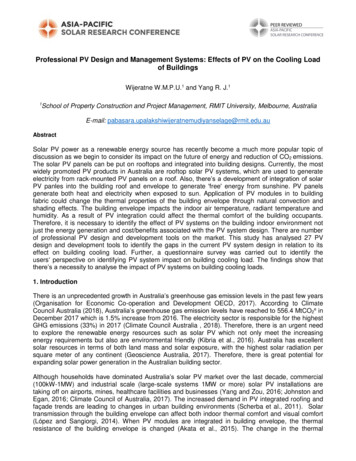
Transcription
Professional PV Design and Management Systems: Effects of PV on the Cooling Loadof BuildingsWijeratne W.M.P.U.1 and Yang R. J.11School of Property Construction and Project Management, RMIT University, Melbourne, AustraliaE-mail: auAbstractSolar PV power as a renewable energy source has recently become a much more popular topic ofdiscussion as we begin to consider its impact on the future of energy and reduction of CO 2 emissions.The solar PV panels can be put on rooftops and integrated into building designs. Currently, the mostwidely promoted PV products in Australia are rooftop solar PV systems, which are used to generateelectricity from rack-mounted PV panels on a roof. Also, there’s a development of integration of solarPV panles into the building roof and envelope to generate 'free' energy from sunshine. PV panelsgenerate both heat and electricity when exposed to sun. Application of PV modules in to buildingfabric could change the thermal properties of the building envelope through natural convection andshading effects. The building envelope impacts the indoor air temperature, radiant temperature andhumidity. As a result of PV integration could affect the thermal comfort of the building occupants.Therefore, it is necessary to identify the effect of PV systems on the building indoor environment notjust the energy generation and cost/benefits associated with the PV system design. There are numberof professional PV design and development tools on the market. This study has analysed 27 PVdesign and development tools to identify the gaps in the current PV system design in relation to itseffect on building cooling load. Further, a questionnaire survey was carried out to identify theusers‘ perspective on identifying PV system impact on building cooling load. The findings show thatthere’s a necessity to analyse the impact of PV systems on building cooling loads.1. IntroductionThere is an unprecedented growth in Australia’s greenhouse gas emission levels in the past few years(Organisation for Economic Co-operation and Development OECD, 2017). According to ClimateCouncil Australia (2018), Australia’s greenhouse gas emission levels have reached to 556.4 MtCO2e inDecember 2017 which is 1.5% increase from 2016. The electricity sector is responsible for the highestGHG emissions (33%) in 2017 (Climate Council Australia , 2018). Therefore, there is an urgent needto explore the renewable energy resources such as solar PV which not only meet the increasingenergy requirements but also are environmental friendly (Kibria et al., 2016). Australia has excellentsolar resources in terms of both land mass and solar exposure, with the highest solar radiation persquare meter of any continent (Geoscience Australia, 2017). Therefore, there is great potential forexpanding solar power generation in the Australian building sector.Although households have dominated Australia’s solar PV market over the last decade, commercial(100kW-1MW) and industrial scale (large-scale systems 1MW or more) solar PV installations aretaking off on airports, mines, healthcare facilities and businesses (Yang and Zou, 2016; Johnston andEgan, 2016; Climate Council of Australia, 2017). The increased demand in PV integrated roofing andfaçade trends are leading to changes in urban building environments (Scherba et al., 2011). Solartransmission through the building envelope can affect both indoor thermal comfort and visual comfort(López and Sangiorgi, 2014). When PV modules are integrated in building envelope, the thermalresistance of the building envelope is changed (Akata et al., 2015). The change in the thermal
resistance of the building envelope has the potential to impact the building indoor air temperature,radiant temperature and relative humidity.2. Impact of PV modules on Building Thermal EnvironmentThere are six primary thermal comfort variables in case of indoor environment: Ambient temperature(air temperature), radiant temperature (the temperature of the surfaces around us), relative humidity(measurement of the water vapor in an air -water mixture), air motion (the rate at which air movesaround and touches skin), metabolic rate (amount of energy expended), and clothing insulation(materials used to retain or remove body heat) (Raish, 2008). These six variables play an importantrole in building thermal environment especially peformance of the Heating Ventilation and AirConditioning (HVAC) system. HVAC is one of the most popular modes of maintaining building thermalcomfort and is generally responsible for a significant proportion of total building energy consumption. Atypical system accounts for approximately 40% of total building consumption in Australia (Departmentof Environment and Energy, 2013). Thus, reduction of cooling load in a building helps saving energyspend for HVAC and in turn CO2 emissions.Both building attached PV (BAPV) modules and BIPV modules can have variety of impacts on thebuilding cooling load. PV modules produce heat, while generating electricity. According to Honsbergand Bowden (2018), for a typical commercial PV module operating at its maximum power point, only10 to 15% of the incident sunlight is converted into electricity, with the remainder being converted intoheat. A study done by Mei et al. (2003) for buildings at three different locations reported that thecooling loads are marginally higher with the PV facade for all locations considered. Therefore, the heatgenerated by PV modules can modify the thermal resistance of building envelope which has thepotential to increase the cooling load of the building.In contrast, the shading offered by the non-integrated or integrated PV panels have an obvious impacton reducing the building cooling load (Macia et al., 2008). For example, the combination of PV andventilated roofs could decrease the cooling load of the building through the roofs (Wang, 2006). Astudy done by Kotak et al. (2014), demonstrated that the energy required for roof-induced cooling loaddecreased between 73% and 90% after installation of the PV system. They pointed out that theshading offered by the PV array aid in reducing the cooling load. A study done by Yang et al. (2001),showed that the cooling-load component through a PV roof with the ventilation gap is about 35%compared with the load of a conventional roof.The findings of the afore mentioned studies indicate different types of BAPV and BIPV have variousinfluences on the building cooling loads. Such impact on the cooling load may vary based on thematerial, mode of construction and other factors, such as insulation level, solar absorptivity, localclimate, etc. (Wang et al., 2006).To find the cooling load, an energy simulation is required. It calculates the heating and cooling energyrequired to keep the building at a comfortable temperature throughout the year. The simulation needsto define the attributes of each room in terms of their adjacency, internal loads, occupancy scheduling,and the material properties of the room (Perkins and Will, 2017). To facilitate this calculation softwaretools are used. However, studies of PV design tools for identifying the impact of PV systems onbuilding cooling load are limited. Therefore, this study has conducted an extensive review to identifythe characteristics of the available professional PV design and management software to identify the
gaps in the current system design. The characteristics will be discussed in the following section withreview of software.Built EnvironmentIndoor airtemperatureSolar PV systemdesignRadiantTemperatureBuildingCooling LoadHumidityFigure 1 Impact of Solar PV system on building cooling load3. Previous Studies on Professional PV Design and Management SystemsWhen considering BAPV and BIPV, each project is unique and therefore requires careful andmeticulous planning to increase the efficiency and cost-effectiveness of the design (Klise andStein,2009; Gridscape, 2013). There are various solar design tools currently available in the market.These tools can be found online, PC based and as smart phone/tablet applications. Many studieshave used the solar PV design tools for calculating solar irradiance, shading loss, energy output,financial viability and 3D modelling of potential PV installations/projects. For example, a study done byAxaopoulos et al. (2014), focuses on six tools, i.e. TRNSYS, Archelios, Polysun, PVSyst, PV*SOL andPVGIS, to compare the energy generation results with the actual data on a grid connected 19.8 kWPV installation. A similar study has been done by Freeman et al., (2014) which validated andcompared the energy production result accuracy within SAM, PVsyst 6.1.1, PV*SOL, PVWatts andRETScreen for nine PV systems. However, only several studies can be found which discuss the useof software to show the effect of PV systems in the building cooling load.Mei et al. (2003) have used TRNSYS to present a dynamic thermal model, for a building with anintegrated ventilated PV façade/solar air collector system. The study has calculated the heating andcooling loads for the building with and without such a ventilated façade and investigated the impact ofclimatic variations on the performance of such buildings. However, they have stated in their study thatwhen calculating the cooling load in TRNSYS the maximum and minimum room temperature limits areuser-set constants. Therefore, it is difficult to set out the temperature setpoints for occupied andunoccupied periods. Thus, the estimations will not be accurate.
Wang et al., (2006), have explored significant influence of BIPV on the heat transfer through thebuilding envelope by simulating PV performances and building cooling-and-heating loads under fourdifferent roofs: ventilated air-gap BIPV, non-ventilated (closed) air-gap BIPV, closeroof mounted PV,and the conventional roof with no PV and no air gap in Tianjin, China. They have used Sandiaelectrical performance model and Radiant time series (RTS) load-model in excel spreadsheet.However, using spreadsheets for complex designs sometimes might not be practical especially forlarge projects.Peng and Yang (2016) have used EnergyPlus to investigate the effects of PV panels on rooftoptemperatures in China. The results show that heat transfer by convection, radiation, and conduction inthe air gap between the PV panels and the building envelope, such as roofs and walls, can besimulated in the EnergyPlus environment when these air gaps are within the “air conditioning zone.”However, the simulated effect that the PV panels have on rooftop temperature was not accurate whenthe air gaps between the PV panels and the building envelope cannot be set as the “air conditioningzone”. This shows that a PV specific tool rather than whole-building energy simulation program couldfacilitate such analysis.A comprehensive study was done within the framework of IEA SHC Task 41 – Solar Energy andArchitecture (Dubois and Horvat, 2010). The study compares 56 software grouped under computeraided architectural design (CAAD) tools, visualization tools and simulation tools. The study hasanalysed the selected tools in terms of aesthetic aspects, technical aspects and economic aspects inSolar projects. As per the study, CAAD tools with a simple user interface and rapid modelling such asGoogle SketchUp were used extensively in the early design phase. More complex tools such as RevitArchitecture and AutoCAD were used in the later project phases. Under simulation software, sometools were preferred in the early design phase (e.g. Ecotect, RETScreen) and more specific andcomplex tools such as Polysun, PVSol were used heavily in later stages. Their study noted thefollowings in terms of analysing building thermal performance; CAAD tools such as BIM applications offer the most interesting possibilities for energysimulations including passive solar gains predictions (e.g: Allplan, ArchiCAD, DDS-CADPV, MicroStation, Revit and Vectorworks). Google SketchUp, which is not a BIM application, also integrates many plugins: IES VEWare, OpenStudio, and Google SketchUp Demeter, which allow performing thermalsimulations based on IES VE, EnergyPlus and Green Building Studio. None of the visualization software reviewed includes any form of algorithm for theprediction of passive solar gains. There are many simulation software which can be used for the prediction of passive solargains. In most cases, the estimation of passive solar gains is considered in the calculationof the whole building thermal balance calculation (e.g.: bSol, DesignBuilder, DPV (DesignPerformance Viewer), Ecotect, EDGII, ENERGIEplaner, eQUEST, IDA ICE, IES VE,LESOSAI, VisualDOE).Further, several past studies such as Klise and Stein (2009), Lalwani et al. (2010), Sharma et al.(2014), Nebojsa Jakica (2017) have been conducted to compare the key features of professional PVrelated tools. However, none of the studies have addressed the impact of PV systems on the coolingload of the building. There is no clear understanding on to what extent PV design and developmentsoftware would help the PV system designers and other stakeholders understand to which extent PVsystems impact the indoor environment thermal load of a building. Clearly, there are not enough
studies in this area. Therefore, this study has conducted an extensive review to identify thecharacteristics of the available PV design and management software to identify the gaps in the currentsystem design in the following section.4. Objectives and MethodologyThe aim of the review is to understand the current features and functions in the current solar PVdesign and management tools in relation to the indoor environment thermal load of a building, andpropose an integrated solution for PV design and development. The main objectives of this study are: Describe the current features and functions of current solar PV design and managementtools in relation to the indoor environment thermal load of a building; Illustrate the limitations; Propose potential improvements for an integrated solution for PV design anddevelopment. The paper’s methodology uses data collected through an extensive literature survey and aquestionnaire survey which was carried out with 15 PV professionals who are working in theAustrialian PV industry. A worldwide search was made for providing diagnosis of photovoltaic designand management systems. Out of many software tools found in the literature review 23 software and 4mobile apps were selected as follows, 13 major standalone PV software packages: SAM Version 2017.1.17, RETScreen Expert,Solarius-PV, Homer Pro, PV *SOL Expert, PV Scout 2.0, Solar F-Chart, Sunulator, Pvsyst,Helos3D solarparkplanung, Polysun, INSEL, SolarPro; 4 CADD/BIM plugins: Google Sketchup, Autodesk Revit, Honeybee and Ladybug tools forGrasshopper; 6 online tools: ArcheliosPro, PVwatts, PVGIS, CalculationSolar.com, PV*SOL Online,EasyPV; 4 smart phone/tablet applications: EasySolar, Onyx Solar, PVOutput, SMA Sunny PortalThe selection of the standalone software and the online tool PV-GIS was based on their usage in thecurrent Solar PV literature where tools that were common in the past studies such as Klise and Stein(2009), Lalwani et al. (2010), Sharma et al. (2014) and Nebojsa Jakica (2017). Further, several onlinetools (Calculation solar, PV*SOL online, Easy-pv and Easysolar) CAAD/ BIM plugin and smartphone/tablet apps were selected based on the studies Nebojsa Jakica (2017), photovoltaicsoftware.com (2017) and Nault et al. (2015). In addition, a questionnaire survey was carried out with15 PV professionals who are working in the Austrialian PV industry. All professionals supported theselection and added Sunnulator, Homer, PV watts and PVsyst to the list which were reviewed as well.Although the listed tools still cannot cover across the world, we endeavor to include the major onesbased on their accessibility and relevancy for BAPV/BIPV design and management. Also, tools whichwere developed specifically for single company PV products such as Fronius Solar Configurator, TheRedback app etc. were not considered in this review. Each solar design and management tool andapp which were free to download for a trial version or where the demo or educational version wasavailable were tested with simulation exercises whereas for software tools with limited access, websites, product manuals, white papers and demo videos etc. were used. The selected tools and the keyfindings from the review are presented in Table 1 and will be explained in the following subsections.
5. DiscussionThe first phase of the work done was to review and analyze the current software related tophotovoltaic design and management available for architects, engineers and other stakeholders of aPV project with a focus on decisions of PV attached or integrated building projects. The results showthat only CADD/BIM tools currently facilitate simulation of building thermal performance with respect toPV system designs (See Figure 2).CADD/BIM 4 smartphone/tabletapplications Google Sketchup Autodesk Revit Honeybee and Ladybugtools for Grasshopper EasySolar Onyx Solar PVOutput MA Sunny PortalOnline tools ArcheliosPro PVwatts, PVGIS, CalculationSolar.com PV*SOL Online EasyPVFacilitate simulation ofbuilding thermalperformanceStandalone PV tools SAM Version 2017.1.17RETScreen ExpertSolarius-PVHomer ProPV *SOL ExpertPV Scout 2.0Solar F-ChartSunulatorPvsystHelos3D solarparkplanung,Polysun,INSEL,SolarProFigure 2: PV design and Management SoftwareThe Revit platform is Autodesk’s purpose-built solution for building information modeling (Autodesk,2018). Within Revit components of a PV attached or integrated building project such as roof, floor,windows, glazing, PV modules, mounting systems, shading, internal loads can be modelled. Further,factors such as solar heat gain in site and outdoor temperatures can be defined. Once model iscreated and spaces and zones of the building are defined, Revit provides the option either to modelthe cooling loads within the programme (See Figure 3) or to export the space load data via gbXML fileor EnergyPlus to an external simulation software programme such as Green Building StudioAutodesk (GBS). Advantages of using Revit for cooling load simulation of PV projects are designerscan introduce both building attached and integrated PV product details to the BIM model; the analysistakes in to account building type, geometry, climate, active systems and envelope properties; designchanges made are automatically updated throughout the model; model can also be exported to thirdparty applications for further analysis; and the information provided in Revit models allow architects ,engineers, designers, contractors and other stakeholders in a PV project to take decisionscollaboratively. Disadvantages are the software can be costly; expert knowledge is required forbuilding the model and it is more suitable for detailed design phase of PV projects and cannot be usedin early design phase
Figure 3: Revit: Cooling/heating load simulationSource: Prakoso (2017)Google Sketchup is a powerful software which can be used for conceptual design stages of PVprojects. Using Sketchup, a building model with PV modules attached or integrated can be created.Then, using Energy Plus OpenStudio plug-in the indoor cooling load of the building model can besimulated. Sketchup require basic skills to learn and easy to use. Therefore, PV project stakeholderssuch as contractors, installers, engineers, researchers etc. could easily simulate the impact of differentPV designs on the cooling load of the building.Rhino Grasshopper simulates the cooling load of buildings using details of the spaces, buildingconstructions, and weather data. It calculates the temperature inside each room for every hour of theyear to calculate the heating and cooling energy required to keep the temperature inside each roomcomfortable when people are using each room (Perkins and Will, 2017). Honeybee and Ladybugcomponents for Grasshopper interface to OpenStudio component and EnergyPlus facilitate coolingload simulation (See Figure 4). In contrast to Google Sketchup, Rhino Grasshopper require expertknowledge to run its applications.Figure 4: Honeybee: Cooling/heating load simulationSource: Perkins and Will (2017)The findings in the above section show that most of the PV design and development tools does notconsider the impact of PV systems on the indoor environmental thermal loads. The tools that facilitatethis feature such as Honeybee and Ladybug components for Grasshopper, Sketchup and Revitrequire substantial knowledge to operate the software. Therefore, it is impractical especially forresidential owners and those who are not familiar with the software. Thus, it would be beneficial if thecurrent PV design tools could provide a platform or framework on how the proposed design will affectthe indoor thermal load of the selected building.The second phase of the project aimed to learn from users, i.e. engineers, architects, PV installers etc.A questionnaire survey was used find out the limitations and improvements of the currently availabletools for solar design and its impact on the building thermal environment.
Limitations of current PV design practice: Lack ofconsideration on building cooling load0%Very Critical50%50%Somewhat CriticalNot CriticalNo Experience0%Figure 5: Limitations of current PV design practice: Lack of consideration on building coolingloadRespondents were asked to choose the limitations of the current PV design tools and rate thecriticalness of the selected limitation. Half of the survey responses indicated that building cooling loadis not critical for designing a PV system and half of the survey responses agreed that building coolingload should be considered in designing PV systems (See Figure 5). The Respondents were thenasked about the needs for improvements required and in total 60% have agreed that it is important tohave an indoor environmental impact analysis when designing a PV system. However, 20% haveconsidered this option to be not important (See Figure 6).Improvements required in PV design and management :indoor environmental impact analysis20%20%Very ImportantSomewhat ImportantNot Important20%40%No ExperienceFigure 6: Improvements required in PV design and management: indoor environmental impact analysis
This survey results indicate that current PV design software should consider the impact of PV designon the building thermal environment. The above survey results indicate that there’s a necessity tounderstand the impact of PV design on the building thermal environment. However, relatively littleresearch has been published on the impact of attached and integrated PV on the buildings coolingload. Further, not many PV design tools facilitate simulation or calculation of the impact of PVsystems on building cooling load. Therefore, there should be an integrated solution to facilitate thisprocess. The proposed solutions can be identified under information and simulation and analysisoptions as shown in the Table 1 below;Table 1: Proposed solutions for an integrated platform for PV design and developmentCategoryInformationSimulation andanalysisoptionsProposed Improvements Detailed local meteorological data and local geographic/terrain data withminimum time intervals Localised PV system product database (e.g. panel, storage, BOS) Localised cost data on PV system products and installation Localised energy price data Accurate energy consumption data Information on local building regulations and codes Information on local government incentives and policies Information on financial modes and contract arrangements Database on previous project examples Information on product performance in previous projects Information on commissioning and O&M procedures Efficient 3D model creation of the physical environmentGeneration and comparison of alternative PV module designsVisualization of shading impact and lossesAutomatic PV system configuration and optimizationAnlysing the building cooling loadAccurate energy consumption data simulationMatching and optimizing energy outputs with fluctuating demands andelectricity prices Balancing revenue against cost to optimise PV module and storage sizes Lifecycle cost-benefit analysis and comparison from differentstakeholders’ perspectives Sensitivity analysis by changing simulation and assessment factors6. ConclusionSolar PV design and management is a complex process which span across the interests ofmultidisciplinary stakeholders. A PV project decision is not only based on the amount of powergenerated. It also should consider the impact of the installation to the indoor environment thermalloads. 23 PV design and management software and 4 apps were examined on their capability forcalculation of building cooling/heating load before installation and after installation. The findings of thisreview showed none of the examined software except Google Sketchup, Rhino grasshopper andAutodesk Revit can be used to identify the impact of BAPV/BIPV system on the building indoorcooling/heating load. Additionally, the questionnaire survey findings indicated that there’s arequirement for analyzing indoor environmental impact with PV designs. Therefore, studies on theimpact of PV designs on the building thermal environment are required to upgrade the current PVdesign tools.Further, an integrated solution which consider the informational requirements and
simulation andanalysis requirements should be established to calculate the impact of PV on the indoorthermal load of buildings.ReferencesAkata, M.A.E., Njomo, D. and Mempouo, B., 2015. ‘The effect of building integrated photovoltaicsystem (Bipvs) on indoor air temperatures and humidity (Iath) in the tropical region of Cameroon’.Future Cities and Environment, 1(1), p.1Autodesk(2018).AboutEnergyAnalysisforAutodesk Revit t/revit-products/learn-explore/ [Accessed 25 November 2018]Climate Council of Australia, 2018. Australia’s Rising Greenhouse Gas Emissions. Available loads/2018/06/CC MVSA0143-Briefing-PaperAustralias-Rising-Emissions V8-FA Low-Res Single-Pages3.pdf [Accessed 22 September 2018]Geoscinece Australia, 2017. ‘Solar energy’. Available at: #heading-1 [accessed 28November 2017].Honsberg C. and Bowden S. (2018). Heat Generation in PV Modules. es/heat-generation-in-pv-modules[accessedNovember 2018].at:26Johnston, W. and Egan, R., 2016. PV in Australia Report 2015. Australian Photovoltaic Institute,Sydney, Australia, p.44.Kibria, G., Haroon, A.K. and Nugegoda, D., 2018. Low-Carbon Development (LCD) Pathways inAustralia, Bangladesh, China and India—A Review. Journal of Climate Change, 4(1), pp.49-61.Klise GT, Stein JS. Models used to assess the performance of photovoltaic systems. Sandia Report,Sand2009-8258; December 2009.Kotak, Y., Gago, E.J., Mohanty, P. and Muneer, T., 2014. ‘Installation of roof-top solar PV modulesand their impact on building cooling load’. Building Services Engineering Research and Technology,35(6), pp.613-633.López, and Sangiorgi. "Comparison Assessment of BIPV Façade Semi-transparent Modules: FurtherInsights on Human Comfort Conditions." Energy Procedia 48 (2014): 1419-428.Mei, Infield, Eicker, and Fux, 2003. ‘Thermal Modelling of a Building with an Integrated Ventilated PVFaçade’. Energy & Buildings, 35, no. 6, 605-17.Noone, B., 2013. ‘PV Integration on Australian distribution networks: Literature review’. Australian PVAssociation; 4-35Organisation for Economic Co-operation and Development (OECD), 2017. OECD Economic Surveys:Australia: March 2017: Overview.Prakoso E. (2017). Revit MEP Basic: Heating and Cooling Load Calculation. ooling-load-calculation/ [accessed 24 November ent/energy analysis.html [accessed 24 November 2017].Scherba, A., Sailor, D.J., Rosenstiel, T.N. and Wamser, C.C., 2011. ‘Modeling impacts of roofreflectivity, integrated photovoltaic panels and green roof systems on sensible heat flux into the urbanenvironment. Building and Environment, 46(12), pp.2542-2551Wang, Yiping, Tian, Wei, Ren, Jianbo, Zhu, Li, and Wang, Qingzhao, 2006. ‘Influence of a Building’sIntegrated-photovoltaics on Heating and Cooling Loads’, Applied Energy, 83, no. 9 (2006): 989-1003.
Yang R. J. and Zou P. X.W., 2016. ‘Building integrated photovoltaics (BIPV): costs, benefits, risks,barriers and improvement strategy’, International Journal of Construction Management; 16(1): 39-53Yang, H., Zhu, Z., Burnett, J. and Lu, L., 2001. ‘A simulation study on the energy performance ofphotovoltaic roofs’, ASHRAE transactions, 107, p.129.
influences on the building cooling loads. Such impact on the cooling load may vary based on the material, mode of construction and other factors, such as insulation level, solar absorptivity, local climate, etc. (Wang et al., 2006). To find the cooling load, an energy simulation is required. It calculates the heating and cooling energy











